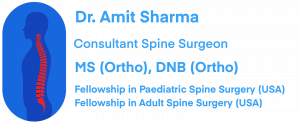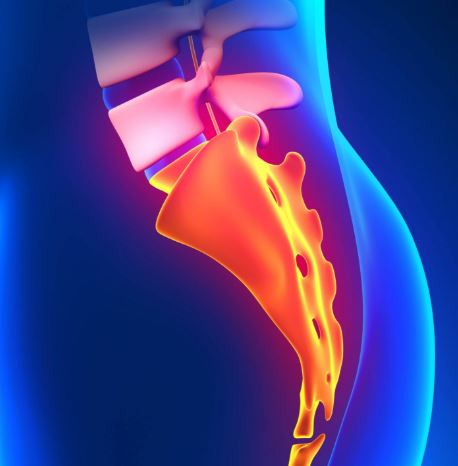Best Spine Surgeon in Mumbai | Dr. Amit Sharma

+91-9967600461
draks777@gmail.com
Coccydynia: What is best treatment for tailbone pain?

Coccydynia: What is best treatment for tailbone pain?
Tailbone Pain Treatment
Coccyx or tail-bone is lowest part or tip of the spine. Pain in coccyx is known as coccydynia. It affect about 2% of the population. Females are affected more. In majority of the cases, coccydynia is associated with history of fall on hips with injury to coccyx.
Causes of Coccydynia:
- Trauma to coccyx due to fall on hips causing coccyx fracture,
- Excessive anterior angulation of coccyx,
- Natural child-birth causing coccygeal injury,
- Chronic irritation of coccygeal area (long sitting, driving, cycling, horse riding etc.),
- Local coccygeal pathology (tumor, teratoma).
- Rectal pathologies.
- Lumbar spine pathologies.
Symptoms:
Primary symptom of coccydynia is pain in the tail bone (tip of spine) region after prolonged sitting. Patients are more comfortable lying down, standing and walking. Any activity which puts pressure on coccyx, e.g. cycling, horse riding etc., can aggravate the symptoms. Constipation can also increase the pain which gets relieved by bowel movements.
Diagnosis:
History and clinical examination: Patients usually give typical history of increased pain after sitting, which gets better while standing and walking. On clinical examination, patient will have tenderness in coccygeal area.
Local anaesthetic injection: If a local anaesthetic drug injected in the vicinity of most painful spot on coccyx relieves pain immediately, it confirms the diagnosis of pain of coccygeal origin.
X-ray: An x-ray of coccyx will reveal a fracture in traumatic cases. Excessive anterior angulation will also be detected, if present. A sitting and standing x-ray will show excessive mobility of coccyx.
MRI: MRI is required for patients with chronic coccygeal pain who do not respond to routine medical treatment. MRI will reveal presence of bone edema at the site of fracture. MRI will be very helpful in differentiating between a real fracture or normal sacro-coccygeal joint seen on a x-ray as fracture. A sacro-coccygeal tumor/ teratoma can also be diagnosed by MRI only. MRI screening of lumbar spine will be helpful to confirm/ rule out a lumbar spinal pathology.
CT Scan: CT is rarely required to assess a fracture involving sacrum and coccyx.
Treatment:
Routine pain medicines and anti-inflammatory medication to help alleviate pain and reduce the inflammation is given for symptomatic treatment. An air ring or a cushion with a cut-out at the back (in the coccygeal area) will offload the coccyx during sitting. Stool softeners are given to relieve constipation to prevent straining the coccyx during defecation. Sitz bath in a lukewarm water reduces pain.
Physiotherapy: Pelvic floor strengthening exercises (e.g. Kegel exercises) reduce inflammation around coccyx. Posture control with straight sitting to avoid coccyx touching the sitting surface is required. It’s better to avoid sitting on floor for the same reason. Sitting on a very soft surface (e.g. sofa) will make ischial tuberosities to get buried in soft surface and will bring coccyx in contact with surface causing pressure on it. Hence, a firm/ semi-firm surface is preferred for patients with coccydynia.
Manual massage of coccyx with thumb in the anus and fingers on the outer aspect of the coccyx has shown positive result in 63% patients. However, patients’ acceptability for the treatment is very low.
Local injection: A local injection of steroid and local anaesthetic mixture is most commonly used treatment for non-resolving coccydynia. This is more effective in cases with hypermobility and fractures. Similarly, Temporary or permanent nerve blocks are sometimes applied in cases of coccydynia.
Surgical Treatment (Coccygectomy): Surgical excision of the coccyx can be tried in patients with failed medical treatment and local injections. Results of the surgery are not very predictable. Hence, surgery is kept as a very last resort and a thorough patient counselling is required. Persistent/ residual pain after the surgery is treated with medical line of treatment and repeat local steroid injection. Nerve stabilizer medications (Gabapantene, Pregabalin) can also be given for pain relief. Surgery is usually successful when there is an obvious coccygeal fracture or hyper-mobility. Surgery is also required in cases of tumor or local teratoma.
Tailbone Pain 29.12.2021 after sleep my office July 2022 pain increase
Please send detailed information on email draks777@gmail.com
Please send detailed history.
Examining coccydynia offers a comprehensive understanding of tailbone pain, shedding light on its varied causes and treatments. By highlighting common symptoms and diagnostic tools, the article underscores the importance of a tailored approach to care. The emphasis on the range of treatments, from physiotherapy to surgical intervention, accentuates the intricate nature of addressing coccydynia and the need for personalized patient pathways. The piece is valuable for those seeking clarity on this often-overlooked pain condition.
Thank you for your comments
I have had this condition for a few years now…Tried many things with nothing really working…An anti inflam in daytime…Gaba etc at night….and just learn to live with pain…open to ideas
You should try local steroid injection.